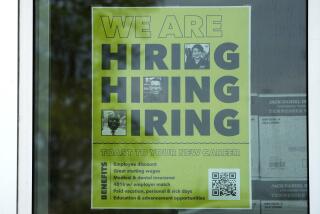Worker productivity falls -- but that’s good for the job market
Employee productivity took its biggest slide in a year, not because workers are slacking off but because businesses are boosting their head counts to keep up with demand.
That’s a good sign for the job market. It shows that bosses, who whittled their ranks during the lean years, are no longer able to squeeze as much output as they once were from their skimpy workforce.
Despite frail GDP growth last quarter, demand for goods and services was strong (though it may be starting to slacken, depending on whom you ask). To maintain momentum, companies had to increase hiring.
As a result, non-farm productivity slid at a 0.5% annual rate in the first quarter after gaining 1.2% in the fourth quarter and 8.3% at its peak during the recession, according to the Labor Department. That’s the largest quarter-over-quarter drop in a year.
That’s even though the hours that employees worked increased 3.2%. Productivity is measured as the amount of output produced (up 2.7%) for each hour of work.
Labor costs for companies were up 2% per worker in their third straight quarterly increase. It’s the first time such a run-up has happened since the recession began, and economists are now keeping an eye out for signs of inflation.
Unfortunately for employees, hourly compensation was up just 1.5%.
The employment reports littering the path to the government’s official April jobs numbers Friday have been mixed. On Thursday, the Labor Department said that first-time jobless claims fell much more than expected last week in the largest slide in nearly a year. A private report from ADP on Wednesday, however, said hiring made its smallest gain in seven months.
RELATED:
U.S. jobs report takes on outsize significance
Jobless claims fall sharply after three weeks of increases
Best study ever: Wasting time online boosts worker productivity
Follow Tiffany Hsu on Twitter and Google+
More to Read
Inside the business of entertainment
The Wide Shot brings you news, analysis and insights on everything from streaming wars to production — and what it all means for the future.
You may occasionally receive promotional content from the Los Angeles Times.











